
Hiking Adventure Experience from Lugu Lake to Daocheng Yading
For thousands of years, there are the oldest nationalities and legends in the three gorges of the sun(太阳峡谷), Ninglang(宁朗峡谷) and Gongga(贡嘎峡谷).The magical and beautiful natural scenery looks like a dusty picture album. More than 70 years ago, it was opened by Joseph Alfred Locke, anAmerican Austria botanist and explorer and was crowned the garden browsed by God, so that the magnificent, beautiful and mysterious landscapes could be enjoyed by people all over the world. Because of the wars and other historical reasons, it has been forgotten in time once again, watching the eternal legend stirlessly and silently.
It is the dwelling place of the gods, the garden of God, and the heaven of the human world. There is everything you can imagine and all that beyond your imagination. It is a fantastic place to be described, in which the sky reflectsthe color of heaven and the lake shines upon the reflection of the soul.
The heart is yearning for, can the body not go for worship?
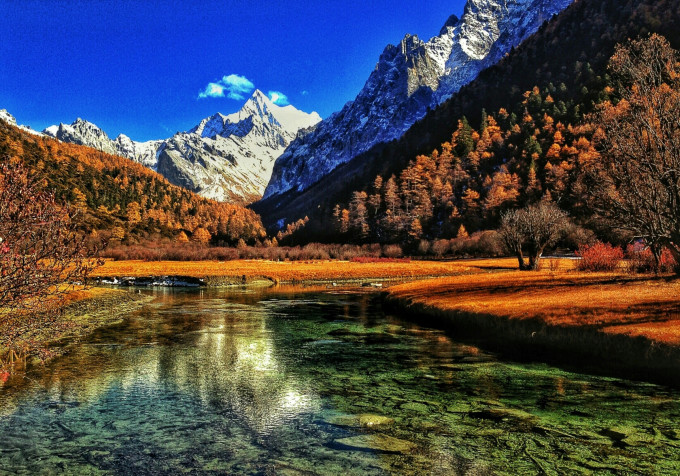
The introduction of scenic spots
Lugu Lake(泸沽湖)
Lugu Lake(泸沽湖)with surface altitude of 2,685m above the sea level is located between Ninglang county of Yunnan (云南宁蒗)and Yanyuan County of Sichuan(四川盐源), 72 km away from Ninglang county (宁蒗县), like a crystal stone inlaid in the mountains of Northwest Yunnan Plateau. The lake with the whole area about 48.5 square kilometers, 30.5 square kilometers of which located in Yunnan and the total water capacity of 1.953 billion cubic meters, flows eastward into Yazhe River (雅詟江)and finally going to the Jinsha River(金沙江), which is a section of Yantze River(长江). Lugu Lake bears an average depth of 45m with the deepest of 93.5m, which is second to Huxian Lake in Chengjiang county in Yunnan.
The entire lake looks like hoof, long in north and south direction and narrow in west and eastward, and the shape of which is like a gourd, thus it is named Lugu Lake. The Mosuo people with the matriarchal characteristics live alongside the wonderful landscape, which is rarely found home and abroad.Because of the unique a’xia marriage mode, natural and primitive folk customs adding the mysterious and beautiful mood to this ancient land, it is regarded as the magical oriental girl country.
Firstly, thanks to the Mosuo people remaining the primitive matriarchal society and A’xi marriage customs, in which a man doesn’t really marry a woman residing along the lake for generations, secondly, the cultural tradition of Female in most priority still affecting the daily life around Lugu Lake, thus the scenery of the lake is full of elegant and ethereal features. When you travel along with the route, you can feel like marching into the holy land of the goddess.
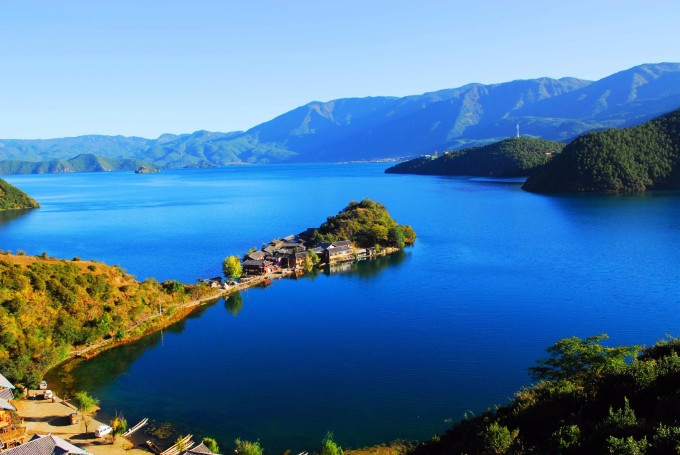
Karst Valley
Karst Valley is located on the westside of the Gongga snow mountain, South to the Castro village, and the east to the Xigerang(希格让)ancient cirque on the southwest slope, with length of 12 kilometers and a maximum depth of 1000 meters in the valley. The precipice is extremely high and magnificent.The scenery spots shaped by the gorgeous stones such as the hell gate, the temple of ghost king, the ghost cliff, Rulaifeng, black waterfall etc, are so vivid and imaginable. The stone images of magic mirror, balance, sword even the torture in the hell weathered from the dolomite are quite coincident with the legend of the Castro Valley, one of the eight cold forests(corpse forest) prescribed in the Buddhist Classics, which is the only way for the human body transferring to the heaven. Once you hike across the Castro Valley, you definitely reach the heaven, Castro Village, which is located at the ditch entrance of the Castro Valley. There are 27 Tibetan households in the village. The houses of the village are almost the 3-stoery Tibetan structure with reasonable and nice layout. The village is constructed close to the grand Zhong’en Mountain, on which there are two peaks faced to each other, with stream flowing.

Aden Three Holy Mountain
The Three Holy Mountain of Aden Daocheng consists of three snow peaks of XianNairi, YangMaiYong and SianoDorji, representing Avalokiteshvara, Manjusri Bodhisattva and Jin Gang Bodhisattva respectively. The three peaksare snow capped all the year around and almost touching the sky. It is ranked No.11 out of the 24 Holy mountains in the Buddhist world based on the Buddhist Classics The holy scene of our daily Secretaries. It is regarded as the holy place for the people who were born in the year of rooster. If a person goes around the mountain once, the merits of him/her might be more than reciting 100 million times of Om mani padme hum(嘛尼).If pilgrimagecarried in the year of rooster of Tibetan Calendar, the merits could be increased greatly.
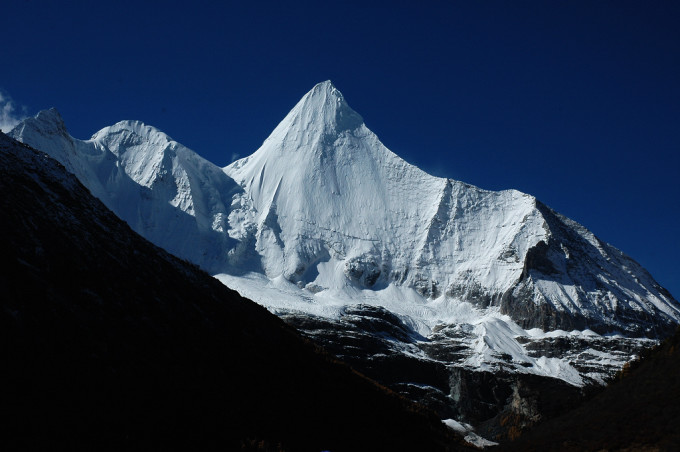
Chonggu Temple
Chonegu Temple is located at the foot of Xian’nairi snow peak with an altitude of 3880m above sea level. For its superior position, it becomes a famous camping site within the scenic area. Not only the required place to enjoy the Three Holy Mountain namely Xian’nairi, Yangmaiyong and SianoDorji, but also is it the start for the Tibetan mountain ceremony.

Luorong Pasture
Luorong pasture with magnificent scenery and surrounded by grassland is one of the most famous places to stay within the Aden scenic area, with an altitude of 4,150m above sea level, which is the meadow for the villagers nearby in the high mountain. In May of the year, the luxuriant grassland and the yaks could be viewed, meanwhile, it is the best spot for sightseeing the Three Holy Mountain. After hiking a long journey, people can camp here or lodge a tent on his own. The travelers can breathe the air from the holy mountain and feel the snow water closely as well as enjoying the views of snow peaks, forest, grassland, creeks, lake, waterfalls, and wooden houses at pasture. It is the true meaning of approaching the nature.

Schedule Description
There are two routes from Lugu Lake to Daocheng Aden, which we call the Line A and Line B. The Hot spring township(温泉乡) is the starting point for both hiking lines.
Line A: Spring Town(温泉乡) to Xiayiji(下依吉) to Kawa(卡哇) to E’yatong(俄牙同) to Dongyi(东义) to Gewa(各瓦) to Kasi(卡斯) to Riwa(日瓦) or hiking across the Castro Valley from Castro village to Chonggu temple and Aden then reaching Daocheng.
Line B: Spring town(温泉乡) to Lijiazui village(利加嘴村) to Wujiao village(屋踋村) to Wujiao town(屋踋乡) to Yangpeng(羊棚) to Dakeguduo pass(达克谷多垭口) to Karl pasture Que’ershan(卡尔牧场雀儿山) to Qiongying village(邛引村) to Ludu village(卢杜村) to Tongtian Riverside(通天河边) to Dongla village(东拉村) to Dulu village(杜鲁村) to Sijia village(四家村) to Gold mine(金矿) to Galuo village(嘎洛村) to Galuo pasture(嘎洛牧场) to Galuo pass (嘎洛垭口) toSianoDorji pass(夏洛多吉垭口) to Chonggu temple(冲古寺). If time and strength allowed, the travelers can travel to Luorong pasture from Chonggu temple then hike across the Castro Valley to Castro village, then renting a car to Riwa, then travel to Daocheng by car from Riwa. If not, the hikers can goback to Daocheng directly from Chonggu temple.
Line A could be easier but the scenery is slightly inferior to Line B, which overlaps the original route that Locke used from Lijiazui, referring to Mapping a Circle to the Most Beautiful Places in China from Chinese National Geography.
The more difficult alignment goes, the more beautiful scenery is. In comprehensive consideration for no regrets, Line B should be taken, in addition, the trip of hiking the Castro Valley to Castro village should be made.
Route Schedule
Day 0: (September 26th) Chengdu
Gathering in Chengdu for all members and accommodation to the hotels near AUX Plaza (various hotel grades available) for non-Chengdu residents, hot pot meal for supper at night
Recommended accommodation: AUX Plaza Hotel, hostel, locally-owned accommodation, Youth Apartment
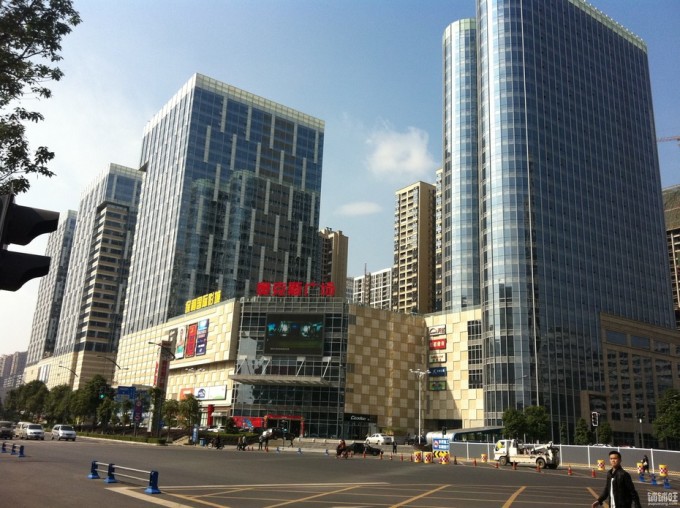
Day 1: (September 27th) Chengdu – Ya’an – Xichang – Lugu Lake
Gathering at the No.4 gate of AUX Plaza to Lugu lake by bus 6 a.m. For the long journey, 2 drivers are arranged. ETA to Lugu lake at 9 p.m.
Food: breakfast by yourself, and fast food provided for lunch and dinner along the bus trip
Accommodation: Lugu lake town
Altitude: 550m in Chengdu and 2650m in Lugu Lake.
Day 2: (September 28th) one day rest in Lugu Lake
You can get up later for recovering your energy due to last day’s long journey. Activities are freely arranged by the members, such as boating, lake view sightseeing, hiking, tea drinking. The team leader should check the necessity, horse required, route scheduled with the local guide and buy other required materials for hiking. Gathering at Lugu lake inn at 4 p.m. to Spring town (starting point for hiking) by bus. You can enjoy a spa there at night.
Food: breakfast, lunch, and supper by your own
Lodging: Hot Spring Township
Altitude: 2600 meters above sea level in Spring Township

Day 3: (September 29th) Springs Town to Lijiazui to Wujiao Town
Gathering with guiders at 8 a.m. after breakfast in Spring town. Picking up equipment and starting from 8.30 a.m. for 6-8 hours hiking. Camping at Wujiao Town at night (accommodation in local villagers available)
Food: Breakfast provided at Inn; lunch by your own: dinner: Wujiao Town to or self boiled.
Lodging: camping or living in the villager’s house (cost self-care)
Altitude: 3000 meters at Lijiazui; 2700 meters at Wujiao village

Day 4: (September 30th) Wujiao Town(屋踋乡) to Shuiluoga(水洛嘎) to Yangpeng(羊棚) to Cigu(茨姑) to Niupeng(牛棚) to Dakegu pass(达克古垭口) to Que’er shan pass(雀儿山垭口下)
Commencement at 7:30 a.m. hiking along the road to Kega (small shop available) then climbing Bodhisattva mountain, passing Yangpeng, Ci’gu to Niupeng. Note, there is one section with leech before reaching Niupeng.
Food: camp cooking for breakfast; lunch on Road by your own; dinner: camp cooking
Accommodation: Camping at Que’ershan Pass
Altitude change: 2700m – 3800m – 4200m – 4000m
Hiking time: 7:30 – 18:00
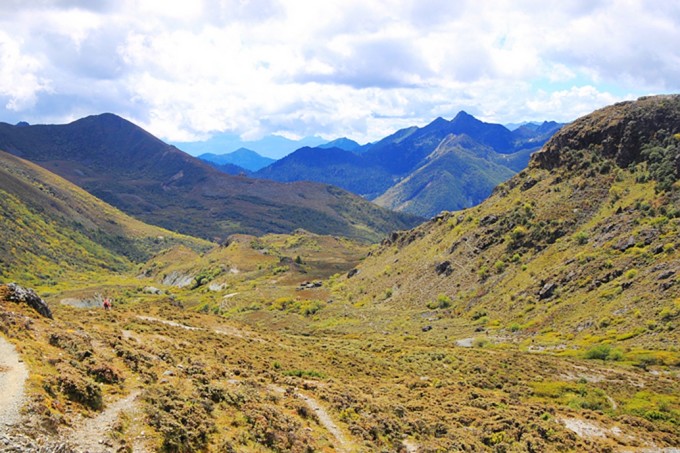
Day 5: (October 1st) Que’ershan Pass (雀儿山垭口) to Water grass land(水草地) to Ta’sigou Pass(塔斯沟垭口) to Ta’sigou(塔斯沟) to Primitive forest (原始森林) to Qiongyi Village(邛依村)
Note: Landscape in Ta’sigou is more beautiful, but it needs to go through asmall swamp and comfortable shoes are necessary.
Food: breakfast at camp; lunch: on the road by your own; dinner: camp cooking or eating in Qiongyi village household
Accommodation: Qiongyi village lawn camp
Altitude change: 4000m – 4100m – 3900m – 3000m
Hiking time: 8:00 – 18:00
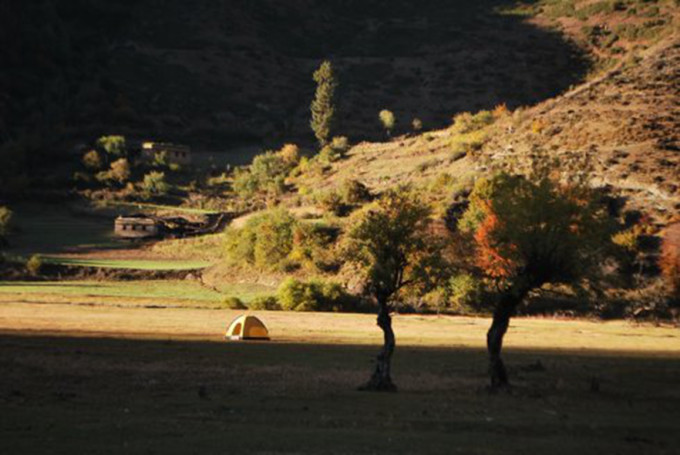
Day 6: (October 2nd) Qiongyi village(邛依村) to Primitive forest(原始森林) to Qiongyishan Pass (邛依山垭口) to Ludu village(卢杜村) Tongtian riverside (通天河边) to Shuiluo bridge(水洛桥) to Tongtian river camping site(通天河边露营营地)
Note: The water quality of the Tongtian river is not very good; The elevation difference is more than 1000 meters, and it is necessary to pay attention to the altitude stress.
Food: breakfast camp cooking; lunch: on the road by your own; dinner: camp cooking
Accommodation: Tongtian River Camping
Altitude change: 3000m – 3900m – 2200m
Hiking time: 8:00 – 18:00
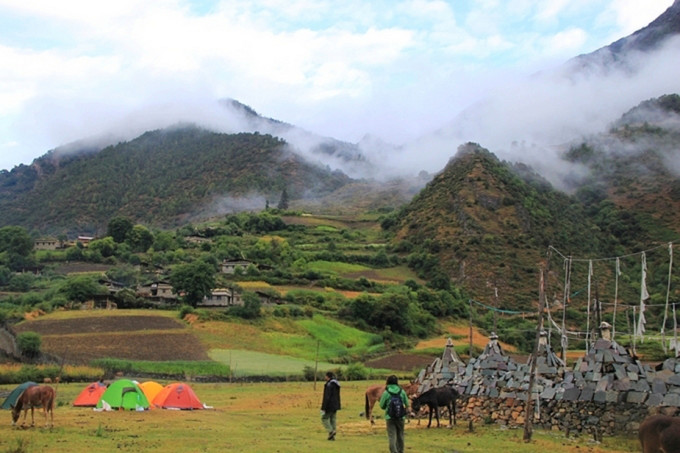
Day 7: (October 3rd) Tongtian River Camping Site(通天河边扎营地) to Dongla Village(东拉村) to Dulu Village(杜鲁村) to Sijia Village(四家村) to Gold Mine(金矿) White River(白水河)
Note: The water quality of the Tongtian river is not very good; The elevation difference is more than 1000 meters, and it is necessary to pay attention to the altitude stress.
Food: breakfast camp cooking; lunch: on the road by your own(if passing the village, you can eat at local households at your own cost); dinner: camp cooking
Accommodation: Making a floor bed at home of mine workers. If hiking fast, the travelers can camp along the White River or at Galuo Village (based on the physical condition of travelers)
Altitude change: 2200m – 3000m – 2500m – 2800m
Hiking time: 8:30 – 18:30
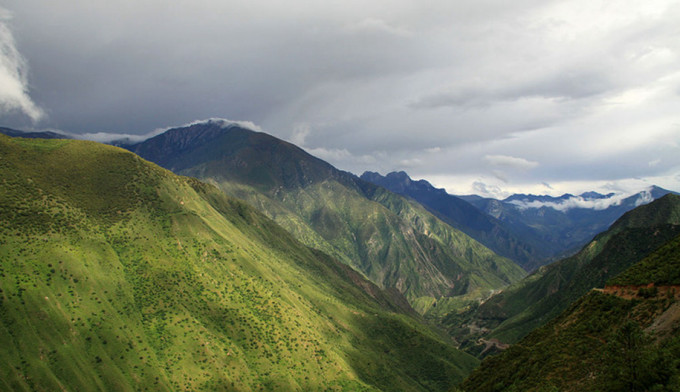
Day 8: (October 4th) Gold Mine(金矿) to Galuo Village(嘎洛村) to Galuo Pass(嘎洛垭口) to Galuo Pasture(嘎洛牧场)
Note: high altitude camping here, pay attention to the altitude stress.
Food: breakfast camp cooking; lunch: Road meal self-care; dinner: camp cooking
Accommodation: Galuo pasture camp.
Altitude change: 2800m – 4800m – 4300m
Hiking time: 8:00 – 18:00

Day 9: (October 5th) – Galuo Pasture(嘎洛牧场) to SianoDorji pass with altitude of 4900m(4900米的夏洛多吉垭口)(Ri’sa日萨, Chongcaoba虫草坝)to Chong’gu Temple(冲古寺)
Note: The horse of Yunnan caravan will carry all the materials and equipments until SianoDorji pass. Then they will leave. It is about 1 hour trip to Chonggu Temple with horse from scenic spot supporting bag.
Food: breakfast camp cooking; lunch: Road meal self-care; dinner: camp cooking
Accommodation: Camping at Chonggu temple
Altitude change: 4300m – 4900m – 4000m
Hiking time: 9:00 – 16:00
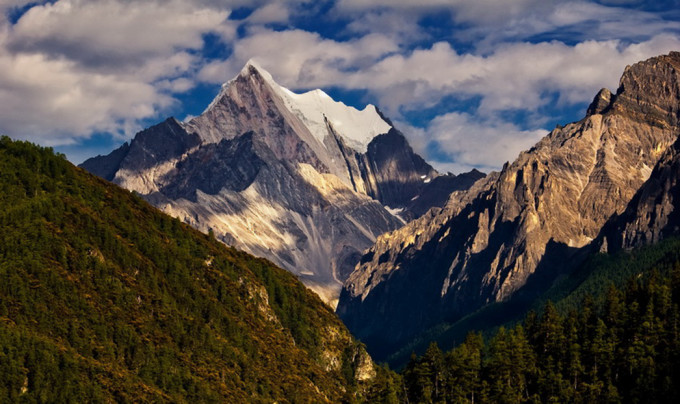
Day 10: (October 6th) -Chonggu Temple(冲古寺) to Luorong Pasture(洛绒牛场) to Milk River(牛奶海) to Yangmaiyong Pass(央迈勇垭口) to Colorful River(五色海) to Pearl River(珍珠海) to Castro Valley (卡斯地狱谷口)
Note: The horse of Yunnan caravan will carry all the materials and equipments until SianoDorji pass. Then they will leave. It is about 1 hour trip to Chonggu Temple with horse from scenic spot supporting bag.
Food: breakfast camp cooking; lunch: Road meal self-care; dinner: camp cooking
Accommodation: Camping at the entrance of the Castro Valley.
Altitude change: 4000m – 5100m – 4000m
Hiking time: 9:00 – 16:00
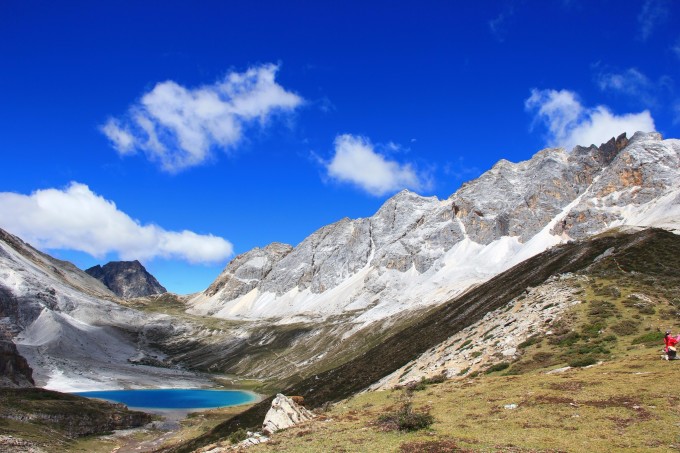
Day 11: (October 7th) -Castro Valley(卡斯地狱谷) to Castro Village(卡斯村) to Er’chushan(俄初山) to Ri’wa(日瓦) (Shangri-la香格里拉乡) to Daocheng(稻城)
Note: It will take 3-4 hours to hike from the Castro Valley to the Castro Village. The members will go back to Daocheng by bus.
Food: breakfast camp cooking; lunch: Road meal self-care; dinner: Daocheng County
Accommodation: Daocheng County
Altitude change: 4000m – 2800m
Hiking time: 3-4 hours
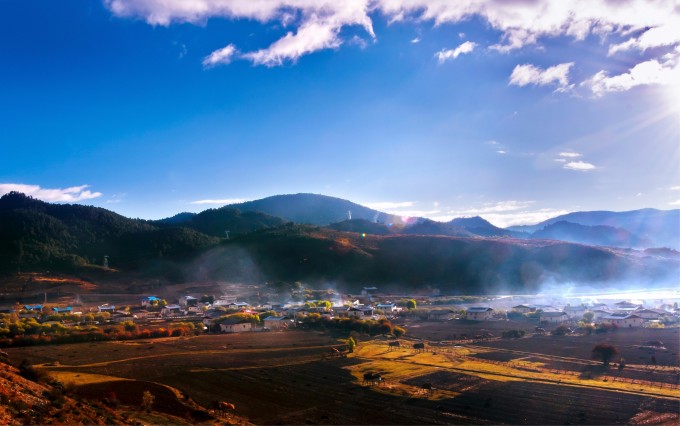
Day 12: (October 8th) Daocheng(稻城) to Xinduqiao(新都桥) to Chengdu(成都)
Note: a long journey back to Chengdu in the late night.
Food: Daocheng County; lunch and dinner: on the road by your own cost.
Lodging: back to Chengdu at night.
Cost & Equipment
Cost included
1. Chartered bus cost for trip from Chengdu to Lugu lake, Lugu lake to Spring town, Castro Village to Daocheng, Daocheng to Chengdu.
2. 12 day of special outdoor activity insurance must be purchased uniformly for everybody.
3. Lodging and food cost for two drivers
4. Public necessity such as wood, rice and oil for hiking.
5.Accommodation fees in Lugu lake, Spring town, and Daocheng county.
6. Horse fees (horse renting and riding excluded)
7. Fees for horse-keeper and guiders (3 guiders arranged, horse-keeper excluded)
8. Walie-talkie (including 5 backup battery)
9. Luxury meal in Daocheng
10. Public cookers
11. Bridge toll and camping charges
Cost excluded
1. Renting & riding horse
2. Tickets for Lugu lake and Daocheng (The entrance is avoided by this specialized route, so no need to buy tickets. However, if you are unlucky, you might be caught for punishment.)
3. Little bottle of gas for personal use ( RMB15/bottle, contact prior to start if need)
4. Fast food on bus (for long bus journey,
5. Meal at village when hiking.
6. Generally outdoor camping during hiking. However, lodging in village or temple for 3 days if available but by your own cost
7. Snacks on road
8. Personal necessary medicine
Equipment List
Essential items: backpack (above 65L), foot small pack, rain cover, tents, sleeping bags, moisture-proof pad, Oxford waterproof cloth, insulation Cup, snow cover, alpenstock (preferably two), gloves, hats (covering ears best), knee pads, thick cotton socks (more than 3 pairs), a pair of hiking shoes (best in high), holding a pair of warm shoes (inside the camp downy, wear, jackets), Zhuarong Yi, quick drying underwear, pants (waterproof), warm clothes and warm pants, jackets, chopsticks (with people), hand or electric headlights, woven bag (installed with backpack), sunglasses or goggles (eyes), raincoat, plastic bags (preparation of several, garbage), waterproof bag (electronic products);
Non essential items:
Camera, tripod, charger, knives, rope (2-3m string prepared for binding), Self heating patch (based on physical condition of each other), sunscreen, lipstick, sanitary napkins (for pad shoes), whistle, towels, knee pads, crampons.
Other
Note
Climate: rain, or snow, or hail, between -10 and +15, the climate changes violently and infrequently
Altitude: from 2000 to 5000 meters, most places are about 2000-4000 meters
Animal:
1, never provoke the Tibetan Mastiff
2, leech area, mosquitoes and fleas
Security:
1, Check the route to hike, road conditions with the guiders and predict the strength of your own every day.
2, Group walking, keep the communication of the interphone smoothly.
3, Confirm the calling methods in advance in case of lost, such as way of blowing whistle, headlight flashing etc.
4. If the distance between the players is large, confirm how to prepare the road sign for the later members.
5. It must be taken into consideration that there is no water in the camp.
Folk Customs:
1. The fireplace is a sacred place for villagers, especially the one faced the door. There is an presided seat, except men’s jacket, other clothes and shoes cannot be allowed to lift to bake. But you are allowed to wear to roast, or the host doesn’t care.
2. The people of Mosuo, Tibetan or nearby ethnic minorities remain a custom that no matter what and how the hostlers, guiders and the villagers along the road assist you, the cigarette and tea brick would be sent to them for help. There is an local sentence that no matter where you are from, you are friend.
3. Do not forget to send a smoke to the local women
4. Prepare some small gifts (stationery, candy) to the local Haizi and bring some more medicine to the villagers
5.Respect the mountain and respect the customs of the local ethnic groups. Ask your guide if you can’t understand it
Other:
1. Pay attention to the prevention of blisters for a long time (Watsons blisters resistance products suggested)
2. Safety of drinking water and prevention and treatment of gastrointestinal diseases.
3. waterproof shoes or military rubber shoes are necessary.
4. Prepare some portable raincoats
Chinese Version: http://www.mafengwo.cn/i/5613911.html













